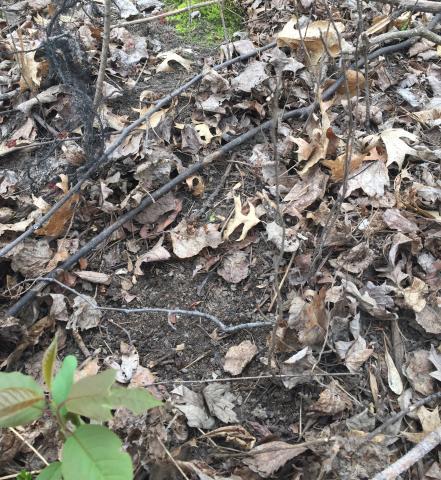I have had the pleasure of working in forests on a wide variety of soil types. The ones I have the most experience on are the clay-loam at the family farm and the sand that makes up our home soil. What I have learned is that you can’t ignore what is under your feet when planning your forestry activities. That means knowing what your soil type is before doing any tree planting, choosing which will be your dominant trees now and into the future, and deciding the best time of year to harvest trees.
According to the soil survey, the soil at our home is classified as beach sand. It has a high percentage of sand compared to silt and clay (smaller sized soil particles) and very little organic matter. It doesn’t have much in the way of nutrients for plants to use and doesn’t hold water very well. Additionally, we live in northern Wisconsin, so only a few trees will thrive on our soil including jack pine, red pine, red oak, red maple, and paper birch.
The soil at the farm is much richer (more clay and silt) and can hold water and nutrients better than the soil at our home. The farm is located in the west central part of Wisconsin, so a lot of trees will grow on that soil including spruce, white pine, sugar maple, red oak and a whole bunch more.
The sandy soil at our home does limit us as to what we can plant and successfully grow, but it does have some advantages over the clay-loam soil at the farm. Water moves pretty quickly through sandy soil, so we rarely have standing water on our property. That allows us to get machinery in the woods at our home nearly all year round.
Sand grains are relatively heavy compared to silt and clay, and so are less likely to be washed out by rainfall. Additionally, sandy soil doesn’t compact very much so the damage to our soil from heavy machinery is really minimized. On the flip side, we will often have standing water after a storm on the clay-loam soil at the farm and it is more likely to erode if we don’t protect it. Clay and silt can be compacted by heavy machinery, and rutting in our trails is common when we try to use them following a storm.
We do a fair amount of tree planting and rarely go against what the soil will allow us to do. Occasionally we may plant an interesting fruit tree to see what it does, but otherwise we stick with what we know will grow well on our site. I have seen first hand the results of experiments to push trees outside of their normal range.
For example, I met a landowner who had decided they were going to create a sugar bush on their hunting property by planting a ton of sugar maple seedlings. He had seen sugar maple nearly everywhere he went around the state and it grew well at his home in Milwaukee area. Unfortunately, the hunting land he planted the sugar maple on was a nutrient poor, sandy soil. The trees hung on for a couple of years, but eventually died. All of that time and money he invested was lost because he didn’t think to check his soil first.
So, take some time to figure out what kinds of soils you have on your property and what will grow there. The web soil survey is a great tool, and it can be found at https://websoilsurvey.sc.egov.usda.gov/App/HomePage.htm.
You can also contact your local Wisconsin Department of Natural Resources forester to see what trees will grow on your soil. You can find the DNR forester that works in your county here https://dnr.wi.gov/topic/forestlandowners/locator/index.asp.
Finally, the University of Wisconsin Cooperative Extension office in your county can help you submit your soil for testing on things like how much sand, silt and clay it has and the nutrient content of the soil. You can find information about the UWEX office in your county here https://counties.uwex.edu/.
